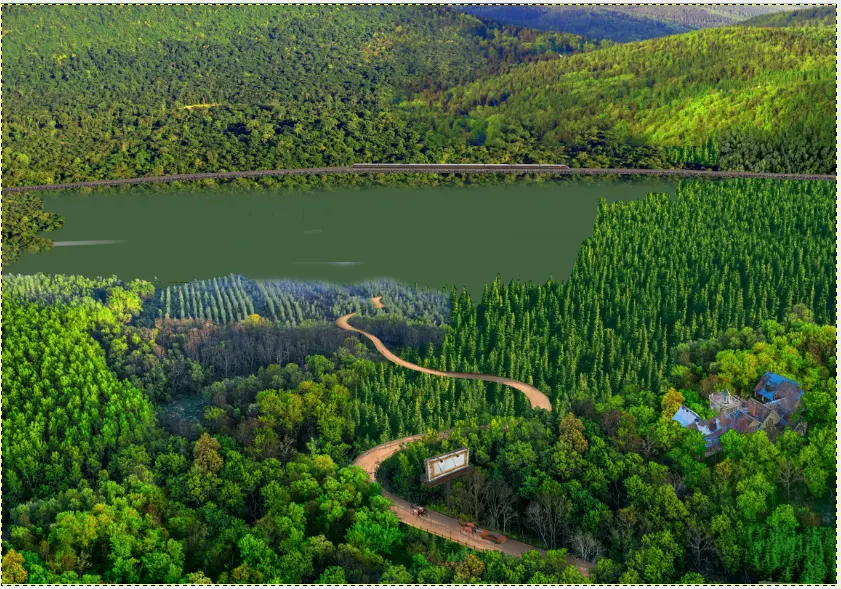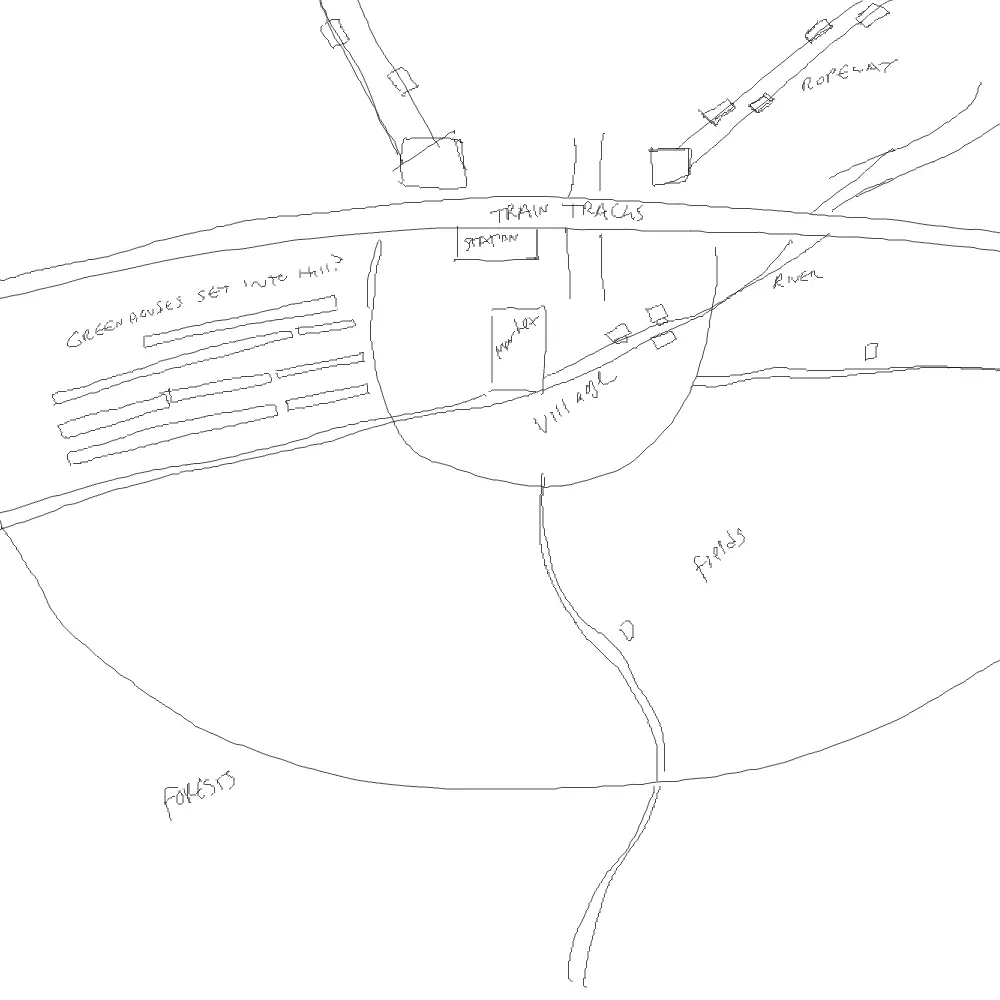Hi, recently I’ve been making these pictures/photobashes of different places in a solarpunk world, trying to demonstrate technologies or other possibilities, or values like reuse that I consider to be solarpunk. I’m working on some cityscapes but I’ve been thinking a lot about rural places since that’s where I’m from, and how they might change with some of the societal crumbles and contractions I feel like are impending. In my grandparents’ time, the region where I grew up was lots of small villages, usually bunched up around water and local industry, with farms spread out beyond that. With cars, people have spread out in these sprawling bedroom communities that are becoming ever more dense with people. Gas and groceries were 40 minutes away by car, and I feel like most people I knew drove an hour each way for work.
I wanted to do a scene sort of showing how things might change in rural areas if cars became impractical (due to shortages etc) and how things could be rebuilt better. I have a sense of what I want to include:
- Dense village surrounded by farms and forest, an abandoned mcmansion or large house far enough out to be impractical
- High speed rail access to the village
- Solar panels
- Waterwheels
- Farms
- Algae farming
For the farms, I could drop in bits and pieces of photos of farmland and make it work, I worked on a farm for a few years and feel comfortable enough for that. But I suspect folks who know more about farming, and especially folks who are into solarpunk visions of the future, might have stronger opinions on how it should be done, so I figure now is a good time to ask. What would you like to see? What should be done differently than we do now? Anything from layouts to the size of fields, to specific crops would be useful.
Edit: this’ll be in North America, by the way. (Probably northern US States though I haven’t picked one) The surrounding trees, general style of mountain, and the buildings will be based on that assumption anyways.
edit 2: here’s the current rough draft to give you an iea of the space I’m planning around
Thanks!



Managing fertility of the soil and weeds will probably be two areas where things will change drastically.
For managing the fertility of the soil without using fossil fuel one of the most promising solution seems to be the use of ramial chipped wood (RCW or BRF in french). It act both as a mulch to prevent weeds and a fertilizer as it decompose.
It is used a by a lot of organic farmers but also industrial farmers that converted their soilless greenhouse of tomatoes plantation to soil by using this technique. They just use a lot (A LOT) of wood to maintain the same level of productivity.
Now to do this kind of farming you need to get the RCW from somewhere. This is where agroforestry become interesting, especially pollarding. By having pollard tree between the crops you get a constant supply of branches to shred directly on top of your crops without needing to transport aver a long distance.
That’s a really cool way to do things! The pollarded trees are very distinctive and should show up well even at a distance. and I like how self-contained this layout seems to be. I’ll have to build the fields out of individual bits and pieces since I’m pretty sure I won’t be able to find aerial photos of a suitable field at the right angle, but it’ll give me a chance to make sure I have the details right.
I’ve started reading up on agroforestry and on Nitrogen-fixing Trees (the far-superior NFTs) and definitely plan to try and make this work. Do you have any recommendations on field size, layout (it sounds like alley-cropping is probably the most common fit in use in the US, but I’m happy to explore other options - some places seem to do straight rows, some do squiggly, irregular ones and I’m not sure why yet. I’m not sure yet what makes the best sense and what will be the most clear visually at this distance) or crops? It’s tough because I want to make sure it’s somewhat realistic for agroforestry but I also want to make sure I’m providing enough food and variety for the village to be somewhat self-sufficient, though there’s a train and this is all going to be pretty tiny anyways so I suppose it’s not a huge deal. I’m also looking at including some kind of algae farming and greenhouses, if there’s any way that could be copacetic with agroforestry I’d be happy to mix them up.
At the moment, my plans go about this far:

I figure the village will probably have some fruit trees inside it, along with taller trees for shade. I might move the river south to show they’re in a pretty dry spot. I can adjust the topology pretty easily but I’d like to have at least some of the chinese-style greenhouses provoq mentioned set on (or into, for bonus temperature regulation) a hill. Outside of that, I can do whatever makes sense. lots of squiggly rows of trees and crops or tiny herd animals between them? straight rows? I’m not sure how organized the fields should look but my instinct is to make some obvious property boundaries and make it look like several different farms occupying the land. not sure how solarpunk that is
Thanks again for the suggestions!
For the village, you can have at what they did in this french village for inspiration:
https://youtu.be/TDbH_s0vvkI?si=KngLjiaoqzzt7hqv&t=2770
There is a greenhouse and fields at the center of village that produces all the vegetable used by the local school for school lunch. The workers for the field are employed directly by the village.
There is few aerial view in the video.
Just watched it, thanks!
I’d like to see this integrated into a process where the wood chips are obtained from a process where they are being produced anyway. I’m a little doubtful about modern attempts at putting a lot of energy for creating wood chips (or also biochar) sometimes with single-purpose processes. Can we use wood chips from other industries? Can we get the biochar from the wood fires in some farms and factories? Wherever they are cutting or planing wood into boards they also produce wood chips. Now I’d prefer they didn’t sell these chips off to turn them into horrible furniture plate as it’s done now - it’s not sustainable and deteriorates after a few years, whereas wood furniture can last more than a person’s lifetime. In some solarpunk future I wish every village or village-sized community had forest/trees dispersed between fields, and a saw mill that can turn them into boards, beams and wood chips - I’d rather not travel further than a few km, and also don’t want to cut my own wood and chips (I’m old and tired).